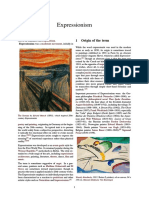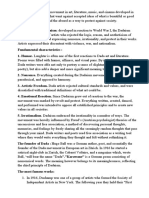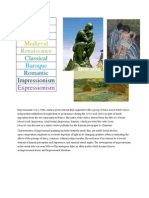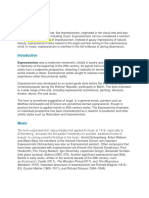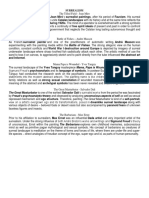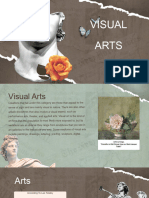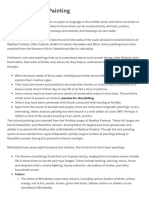0 ratings0% found this document useful (0 votes)
10 viewsExpressionism
Expressionism
Uploaded by
anabelenopia3Expressionism was a modernist movement originating in Germany in the early 20th century that sought to express meaning and emotions rather than physical reality. It developed before World War 1 and remained popular during the Weimar Republic, extending to various art forms including painting, literature, theater, and film. Expressionist works distort reality radically for emotional effect to evoke moods and ideas from a subjective perspective rather than depict objective reality. Some key characteristics included in expressionist works are simplified mythic characters, episodic structures, and heightened intensity.
Copyright:
© All Rights Reserved
Available Formats
Download as PPT, PDF, TXT or read online from Scribd
Expressionism
Expressionism
Uploaded by
anabelenopia30 ratings0% found this document useful (0 votes)
10 views11 pagesExpressionism was a modernist movement originating in Germany in the early 20th century that sought to express meaning and emotions rather than physical reality. It developed before World War 1 and remained popular during the Weimar Republic, extending to various art forms including painting, literature, theater, and film. Expressionist works distort reality radically for emotional effect to evoke moods and ideas from a subjective perspective rather than depict objective reality. Some key characteristics included in expressionist works are simplified mythic characters, episodic structures, and heightened intensity.
Original Description:
Expressionism
Original Title
4427211
Copyright
© © All Rights Reserved
Available Formats
PPT, PDF, TXT or read online from Scribd
Share this document
Did you find this document useful?
Is this content inappropriate?
Expressionism was a modernist movement originating in Germany in the early 20th century that sought to express meaning and emotions rather than physical reality. It developed before World War 1 and remained popular during the Weimar Republic, extending to various art forms including painting, literature, theater, and film. Expressionist works distort reality radically for emotional effect to evoke moods and ideas from a subjective perspective rather than depict objective reality. Some key characteristics included in expressionist works are simplified mythic characters, episodic structures, and heightened intensity.
Copyright:
© All Rights Reserved
Available Formats
Download as PPT, PDF, TXT or read online from Scribd
Download as ppt, pdf, or txt
0 ratings0% found this document useful (0 votes)
10 views11 pagesExpressionism
Expressionism
Uploaded by
anabelenopia3Expressionism was a modernist movement originating in Germany in the early 20th century that sought to express meaning and emotions rather than physical reality. It developed before World War 1 and remained popular during the Weimar Republic, extending to various art forms including painting, literature, theater, and film. Expressionist works distort reality radically for emotional effect to evoke moods and ideas from a subjective perspective rather than depict objective reality. Some key characteristics included in expressionist works are simplified mythic characters, episodic structures, and heightened intensity.
Copyright:
© All Rights Reserved
Available Formats
Download as PPT, PDF, TXT or read online from Scribd
Download as ppt, pdf, or txt
You are on page 1of 11
Expressionism
Introduction to expressionism
• Expressionism was a modernist movement,
initially in poetry and painting, originating in
Germany at the beginning of the 20th
century. Its typical trait is to present the
world solely from a subjective perspective,
distorting it radically for emotional effect in
order to evoke moods or ideas. Expressionist
artists sought to express meaning or
emotional experience rather than physical
reality.
The development of expressionism
• Expressionism was developed as an avant-garde st
yle before the First World War. It remained popular
during the Weimar Republic, particularly in Berlin.
The style extended to a wide range of the arts, incl
uding painting, literature, theatre, dance, film, arc
hitecture and music.
• The term is sometimes suggestive of emotional an
gst. In a general sense, painters such as Matthias G
rünewald and El Greco are sometimes termed expr
essionist, though in practice the term is applied m
ainly to 20th-century works. The Expressionist em
phasis on individual perspective has been charact
erized as a reaction to positivism and other artistic
styles such as naturalism and impressionism.
Origin of the term
• While the word expressionist was used in the mode
rn sense as early as 1850, its origin is sometimes tra
ced to paintings exhibited in 1901 in Paris by an obs
cure artist Julien-Auguste Hervé, which he called Ex
pressionismes. Though an alternate view is that th
e term was coined by the Czech art historian Antoni
n Matějček in 1910, as the opposite of impressionis
m: "An Expressionist wishes, above all, to express hi
mself... (an Expressionist rejects) immediate percep
tion and builds on more complex psychic structure
s... Impressions and mental images that pass throu
gh mental peoples soul as through a filter which rid
s them of all substantial accretions to produce their
clear essence [...and] are assimilated and condense
into more general forms, into types, which he trans
cribes through simple short-hand formulae and sy
mbols."
• Important precursors of Expressionism were: th
e German philosopher Friedrich Nietzsche (184
4-1900), especially his philosophical novel Thus
Spake Zarathustra (1883-92); the later plays of t
he Swedish dramatist August Strindberg (1849-
1912), including the trilogy To Damascus 1898-
1901, A Dream Play (1902), The Ghost Sonata (1
907); Frank Wedekind (1864-1918), especially th
e "Lulu" plays Erdgeist (Earth Spirit) (1895) and
Die Büchse der Pandora (Pandora's Box) (1904);
the American poet Walt Whitman (1819-92): Lea
ves of Grass (1855-91); the Russian novelist Fyo
dor Dostoevsky (1821-81); Norwegian painter E
dvard Munch (1864-1918); Dutch painter Vincen
t van Gogh (1853-90); Belgian painter James En
sor (1860-1949); Sigmund Freud (1856-1939).
• In 1905, a group of four German artists, led by Ernst Lu
dwig Kirchner, formed Die Brücke (the Bridge) in the ci
ty of Dresden. This was arguably the founding organiza
tion for the German Expressionist movement, though t
hey did not use the word itself. A few years later, in 191
1, a like-minded group of young artists formed Der Bla
ue Reiter (The Blue Rider) in Munich. The name came fr
om Wassily Kandinsky's Der Blaue Reiter painting of 19
03. Among their members were Kandinsky, Franz Marc,
Paul Klee, and Auguste Macke. However, the term Expr
essionism did not firmly establish itself until 1913. Tho
ugh initially mainly a German artistic movement, most
predominant in painting, poetry and the theatre betwe
en 1910-30, most precursors of the movement were no
t German. Furthermore there have been expressionist
writers of prose fiction, as well as non-German speakin
g expressionist writers, and, while the movement had
declined in Germany with the rise of Adolf Hitler in the
1930s, there were subsequent expressionist works.
• Expressionism is notoriously difficult to define, in part
because it "overlapped with other major 'isms' of the
modernist period: with Futurism, Vorticism, Cubism, S
urrealism and Dada." Richard Murphy also comments:
"the search for an all-inclusive definition is problemati
c to the extent that the most challenging expressionist
s such as Kafka, Gottfried Benn and Döblin were simul
taneous the most vociferous "anti-expressionists."
• What, however, can be said, is that it was a movement
that developed in the early twentieth-century mainly i
n Germany in reaction to the dehumanizing effect of i
ndustrialization and the growth of cities, and that "on
e of the central means by which expressionism identifi
es itself as an avante-garde movement, and by which i
t marks its distance to traditions and the cultural insti
tution as a whole is through its relationship to realism
and the dominant conventions of representation." Mo
re explicitly: that the expressionists rejected the ideol
• The term refers to an "artistic style in which the artist seeks t
o depict not objective reality but rather the subjective emoti
ons and responses that objects and events arouse within a p
erson." It is arguable that all artists are expressive but there
are many examples of art production in Europe from the 15t
h century onward which emphasize extreme emotion. Such
art often occurs during times of social upheaval, such as the
Protestant Reformation, German Peasants' War, Eight Years'
War, and Spanish Occupation of the Netherlands, when the r
ape, pillage and disaster associated with periods of chaos an
d oppression are presented in the documents of the printma
ker. Often the work is unimpressive aesthetically, yet has th
e capacity to cause the viewer to experience extreme emotio
ns with the drama and often horror of the scenes depicted.
• Expressionism has been likened to Baroque by critics such a
s art historian Michel Ragon and German philosopher Walter
Benjamin. According to Alberto Arbasino, a difference betwe
en the two is that "Expressionism doesn't shun the violently
unpleasant effect, while baroque does. Expressionism throw
s some terrific 'fuck you's, baroque doesn't. Baroque is well-
mannered."
literature
• Two leading Expressionist journals published in B
erlin were Der Sturm, published by Herwarth Wal
den starting in 1910, and Die Aktion, which first a
ppeared in 1911 and was edited by Franz Pfemfer
t. Der Sturm published poetry and prose from co
ntributors such as Peter Altenberg, Max Brod, Ric
hard Dehmel, Alfred Döblin, Anatole France, Knut
Hamsun, Arno Holz, Karl Kraus, Selma Lagerlöf, A
dolf Loos, Heinrich Mann, Paul Scheerbart, and R
ené Schickele, and writings, drawings, and prints
by such artists as Kokoschka, Kandinsky, and me
mbers of Der blaue Reiter. In prose, the early stori
es and novels of Alfred Döblin were influenced by
Expressionism, and Franz Kafka is sometimes lab
elled an Expressionist.
• Oskar Kokoschka's 1909 playlet, Murderer, The Hope of Wome
n is often termed the first expressionist drama. In it, an unnam
ed man and woman struggle for dominance. The man brands t
he woman; she stabs and imprisons him. He frees himself and s
he falls dead at his touch. As the play ends, he slaughters all ar
ound him (in the words of the text) "like mosquitoes." The extr
eme simplification of characters to mythic types, choral effects,
declamatory dialogue and heightened intensity all would beco
me characteristic of later expressionist plays. The German com
poser Paul Hindemith created an operatic version of this play,
which premiered in 1921.
• Expressionism was a dominant influence on early 20th-century
German theatre, of which Georg Kaiser and Ernst Toller were th
e most famous playwrights. Other notable Expressionist drama
tists included Reinhard Sorge, Walter Hasenclever, Hans Henny
Jahnn, and Arnolt Bronnen. Important precursors were the Sw
edish playwright August Strindberg and German actor and dra
matist Frank Wedekind. During the 1920s, Expressionism enjoy
ed a brief period of popularity in American theatre, including pl
ays by Eugene O'Neill (The Hairy Ape, The Emperor Jones and
• Expressionist plays often dramatise the spiritual awakening and suf
ferings of their protagonists. Some utilise an episodic dramatic stru
cture and are known as Stationendramen (station plays), modeled
on the presentation of the suffering and death of Jesus in the Statio
ns of the Cross. August Strindberg had pioneered this form with his
autobiographical trilogy To Damascus. Theses plays also often dra
matise the struggle against bourgeois values and established autho
rity, frequently personified by the Father. In Sorge's The Beggar, (De
r Bettler), for example, the young hero's mentally ill father raves ab
out the prospect of mining the riches of Mars and is finally poisoned
by his son. In Bronnen's Parricide (Vatermord), the son stabs his tyr
annical father to death, only to have to fend off the frenzied sexual
overtures of his mother.
• In Expressionist drama, the speech is either expansive and rhapsodi
c, or clipped and telegraphic. Director Leopold Jessner became fam
ous for his expressionistic productions, often set on stark, steeply r
aked flights of stairs (having borrowed the idea from the Symbolist
director and designer, Edward Gordon Craig.
• Among the poets associated with German Expressionism were Geor
ge Trakl, Gottfried Benn, Georg Heym, Else Lasker-Schüler, Ernst St
adler, and August Stramm. T. S. Eliot has also been labeled an Expr
essionist.
You might also like
- Dơnload Adult ADHD Diagnostic Assessment and Treatment 4th Edition J J Sandra Kooij Full ChapterDocument24 pagesDơnload Adult ADHD Diagnostic Assessment and Treatment 4th Edition J J Sandra Kooij Full Chaptermegzonlaske100% (6)
- Expressionism (Taschen Art Ebook)Document100 pagesExpressionism (Taschen Art Ebook)Francisco José Muñoz Henares95% (38)
- Firmament Vol. 1, No. 4Document100 pagesFirmament Vol. 1, No. 4JoshNo ratings yet
- Artist 39 S Color Manual PDFDocument194 pagesArtist 39 S Color Manual PDFlaparoscopicdr100% (8)
- Expressionism PDFDocument13 pagesExpressionism PDFJaime Quintero89% (9)
- ExpressionismDocument13 pagesExpressionismAndrei Raicu100% (1)
- ExpressionismDocument3 pagesExpressionismAly FahadNo ratings yet
- ExpressionismDocument3 pagesExpressionismgohilharsh0451No ratings yet
- ExpressionismDocument12 pagesExpressionismapi-193496952No ratings yet
- قاموس المصطلحات الادبيةDocument12 pagesقاموس المصطلحات الادبيةMoustafa AbdullahNo ratings yet
- Expressionism: By: Jayson Tibayan and John Albert QuinonesDocument16 pagesExpressionism: By: Jayson Tibayan and John Albert QuinonesDaisy Palero TibayanNo ratings yet
- Expressionism Movement FactfileDocument4 pagesExpressionism Movement FactfilealiciaNo ratings yet
- Expressionism Schoenberg - GroveDocument60 pagesExpressionism Schoenberg - GroveEmanuel RibeiroNo ratings yet
- ExpressionismDocument6 pagesExpressionismDaze GozeNo ratings yet
- ExpressionismDocument13 pagesExpressionismBrinzei LucianNo ratings yet
- ExpressionismDocument6 pagesExpressionismNauman MashwaniNo ratings yet
- ExpressionismDocument47 pagesExpressionismShyyNo ratings yet
- Expressionism 170529160316Document25 pagesExpressionism 170529160316Hood NaeemNo ratings yet
- ExpressionismDocument16 pagesExpressionismRubab ChaudharyNo ratings yet
- ExpressionismDocument2 pagesExpressionismKim Gerald Tejada100% (1)
- L Expressionism in The TheatreDocument10 pagesL Expressionism in The Theatreelmediodia100% (1)
- German Drama Prelude To The AbsurdDocument403 pagesGerman Drama Prelude To The Absurdcerebromagnetico100% (5)
- Art App-ExpressionismDocument20 pagesArt App-ExpressionismErica IsidroNo ratings yet
- Die Brucke: The Bridge - German ExpressionismDocument33 pagesDie Brucke: The Bridge - German ExpressionismKhushboo ChaturvediNo ratings yet
- History of Graphics BGD119Document26 pagesHistory of Graphics BGD119JUSTICE KORANTENGNo ratings yet
- Expressionism 120517184515 Phpapp01Document44 pagesExpressionism 120517184515 Phpapp01Hood NaeemNo ratings yet
- Absurdist SurrealismDocument2 pagesAbsurdist Surrealismrachelle lndNo ratings yet
- ExpressionismDocument5 pagesExpressionismki diNo ratings yet
- German Arts Literature 4Document20 pagesGerman Arts Literature 4Shane Nicole BalmoresNo ratings yet
- Art MovementDocument12 pagesArt MovementMary Jane MalabananNo ratings yet
- Literary MovementsDocument6 pagesLiterary MovementsfirdowsjannathNo ratings yet
- ExpressionismDocument3 pagesExpressionismRaekitNo ratings yet
- Speng 10: Assignment No. 2Document3 pagesSpeng 10: Assignment No. 2BSED ENGLISHNo ratings yet
- Expressionism in The Hairy ApeDocument11 pagesExpressionism in The Hairy Apexx amneziam xxNo ratings yet
- Expressionism in The TheatreDocument7 pagesExpressionism in The Theatrenanarciana0% (1)
- Klasnotas Die Ekspressionisme, Vitalisme, Marsman en Van OstayenDocument8 pagesKlasnotas Die Ekspressionisme, Vitalisme, Marsman en Van OstayenMagrietjieNo ratings yet
- DadaismDocument4 pagesDadaismОксана ШаловилоNo ratings yet
- Hum ArtDocument32 pagesHum ArtEchel AkioNo ratings yet
- Fin de Siècle Movements Friedrich Nietzsche: Literatura AlemãDocument3 pagesFin de Siècle Movements Friedrich Nietzsche: Literatura AlemãPaula BrazNo ratings yet
- Expressionist Art and Drama Before During and After The WeimarDocument58 pagesExpressionist Art and Drama Before During and After The WeimarAnonymous GKLPtGgRqNo ratings yet
- ModernismDocument7 pagesModernismMaria Otilia100% (2)
- ImpressionismDocument2 pagesImpressionismBenjamin ArcairaNo ratings yet
- Expressionism - Mapeh 10Document4 pagesExpressionism - Mapeh 10Rodolph PonceNo ratings yet
- Lesson 2 MAPEH TOWARDS SYMBOLISMDocument41 pagesLesson 2 MAPEH TOWARDS SYMBOLISMfrincessdianne97No ratings yet
- Hugo Ball Flight Out of TimeDocument12 pagesHugo Ball Flight Out of Timespring_into_dada100% (2)
- Arnold Schoenberg (: ( A ʁnɔlt Ʃø Nbɛʁk) Austrian Expressionist Second Viennese SchoolDocument1 pageArnold Schoenberg (: ( A ʁnɔlt Ʃø Nbɛʁk) Austrian Expressionist Second Viennese SchoolusunomNo ratings yet
- Expressionism in Literature: Daria Obukhovskaya 606Document14 pagesExpressionism in Literature: Daria Obukhovskaya 606Дарья ОбуховскаяNo ratings yet
- Expressionism in Literature: Daria Obukhovskaya 606Document14 pagesExpressionism in Literature: Daria Obukhovskaya 606Дарья ОбуховскаяNo ratings yet
- Art and Nihilism, The Poetry of Gottfried BennDocument11 pagesArt and Nihilism, The Poetry of Gottfried BennJuanLuisNo ratings yet
- Modern Drama Is Theatrical Plays Written in 19th and 20th Centuries by Many Playwrights Such As Oscar WildeDocument3 pagesModern Drama Is Theatrical Plays Written in 19th and 20th Centuries by Many Playwrights Such As Oscar WildeMustafa AlaaNo ratings yet
- HH Arnason - Expressionism in Germany (Ch. 08)Document22 pagesHH Arnason - Expressionism in Germany (Ch. 08)KraftfeldNo ratings yet
- Chapter 3 Twentieth Century DramaDocument9 pagesChapter 3 Twentieth Century DramaGauravKumarNo ratings yet
- Week 02, Feb 2ndDocument20 pagesWeek 02, Feb 2ndapc108No ratings yet
- The Tilled Field Is The First of The Joan Miró: SurrealismDocument2 pagesThe Tilled Field Is The First of The Joan Miró: Surrealismkochanay oya-oyNo ratings yet
- GlossaryDocument14 pagesGlossarygiridipak84No ratings yet
- The First Half of The 20Th Century Poetrty: Georgian PoetryDocument13 pagesThe First Half of The 20Th Century Poetrty: Georgian PoetryGiorgia SalemiNo ratings yet
- Post ImpressionismDocument39 pagesPost ImpressionismanthonyNo ratings yet
- He Who Seeks To Define Romanticism Is Entering A Hazardous Occupation Which Has Claimed Many Victims. - E. B. BurgumDocument4 pagesHe Who Seeks To Define Romanticism Is Entering A Hazardous Occupation Which Has Claimed Many Victims. - E. B. BurgumAR MalikNo ratings yet
- Expressionism: By: Erika Ysabelle Flores & Leocarl Francis Montel Gr.10-BernalDocument11 pagesExpressionism: By: Erika Ysabelle Flores & Leocarl Francis Montel Gr.10-BernalYka FloresNo ratings yet
- Visual Arts Standards For NCDocument18 pagesVisual Arts Standards For NCKaren StirnitzkeNo ratings yet
- Kehinde Wileys Napoleon Leading The Army Over The AlpsDocument5 pagesKehinde Wileys Napoleon Leading The Army Over The AlpsBrian WereNo ratings yet
- Kinetic Sculpture: InstructablesDocument21 pagesKinetic Sculpture: InstructableskimcorNo ratings yet
- Soal ToeflDocument5 pagesSoal ToeflAhmad MasagusNo ratings yet
- Catálogo Esenciales Toda Ocasión Qualatex 2022Document24 pagesCatálogo Esenciales Toda Ocasión Qualatex 2022oscar MoralesNo ratings yet
- The Neurophenomenology of Gesture in The PDFDocument18 pagesThe Neurophenomenology of Gesture in The PDFabrahamzapruderNo ratings yet
- 82 Questions About ArtDocument4 pages82 Questions About Artapi-497033322No ratings yet
- The Art World ExpandsDocument35 pagesThe Art World ExpandsAnonymous YoF1nHvRNo ratings yet
- Vienna SecessionDocument36 pagesVienna SecessionVladimir Lav LajovićNo ratings yet
- LECTURE 4 - AD - Academism - 14 - 10 - 2020Document44 pagesLECTURE 4 - AD - Academism - 14 - 10 - 2020Juan Pablo EspínolaNo ratings yet
- Name That PaintingDocument54 pagesName That Paintingcmullikin4163100% (1)
- Contoh Soal Bahasa Inggris SD Kelas 3Document4 pagesContoh Soal Bahasa Inggris SD Kelas 3jonh100% (2)
- Art Appreciation Module 1Document4 pagesArt Appreciation Module 1Michael Anthony Enaje100% (5)
- Putty TDS 2023Document3 pagesPutty TDS 2023mmzamo1No ratings yet
- GE ART Lesson 1Document50 pagesGE ART Lesson 1kentmark guibaoNo ratings yet
- Wooden Block PrintingDocument31 pagesWooden Block PrintingFree lancerNo ratings yet
- Life in BarcelonaDocument16 pagesLife in BarcelonaCassandra PeredaNo ratings yet
- Norman Roth ThesisDocument7 pagesNorman Roth Thesisvxjtklxff100% (2)
- 1stGradeBOEApproved4 21 2020Document16 pages1stGradeBOEApproved4 21 2020Cristina Martin del CampoNo ratings yet
- Mesolithic Rock PaintingDocument5 pagesMesolithic Rock PaintingKrishna GopaliyaNo ratings yet
- HOKUSAIDocument24 pagesHOKUSAISimone NeivaNo ratings yet
- Sigmund Adrian E. Alaba Grade 9 - NewtonDocument2 pagesSigmund Adrian E. Alaba Grade 9 - NewtonAllen AlabaNo ratings yet
- Jumpstart Smiling ChildDocument16 pagesJumpstart Smiling ChildCeleste Mehra100% (1)
- Air Pressure and Airbrushing Distance: BS 637 RLM 78 FS34083-RLM 80 FS35550Document8 pagesAir Pressure and Airbrushing Distance: BS 637 RLM 78 FS34083-RLM 80 FS35550nouchka Lilomimi100% (2)
- 2A Color-WheelDocument42 pages2A Color-WheelJON LESTER CABANESNo ratings yet
- Studies: Series Editors: José Gómez Frechina & Nicola JenningsDocument47 pagesStudies: Series Editors: José Gómez Frechina & Nicola JenningsJuan Garcia TausteNo ratings yet
- KangraDocument7 pagesKangraMohit BharatiNo ratings yet

















